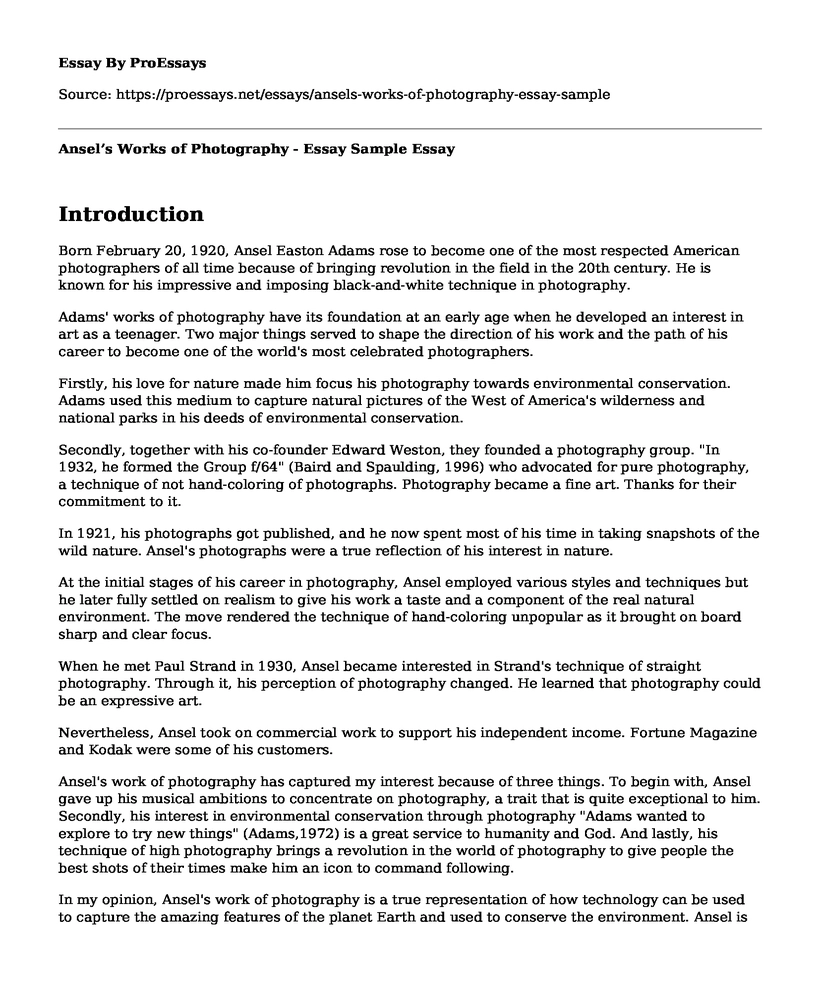Introduction
Born February 20, 1920, Ansel Easton Adams rose to become one of the most respected American photographers of all time because of bringing revolution in the field in the 20th century. He is known for his impressive and imposing black-and-white technique in photography.
Adams' works of photography have its foundation at an early age when he developed an interest in art as a teenager. Two major things served to shape the direction of his work and the path of his career to become one of the world's most celebrated photographers.
Firstly, his love for nature made him focus his photography towards environmental conservation. Adams used this medium to capture natural pictures of the West of America's wilderness and national parks in his deeds of environmental conservation.
Secondly, together with his co-founder Edward Weston, they founded a photography group. "In 1932, he formed the Group f/64" (Baird and Spaulding, 1996) who advocated for pure photography, a technique of not hand-coloring of photographs. Photography became a fine art. Thanks for their commitment to it.
In 1921, his photographs got published, and he now spent most of his time in taking snapshots of the wild nature. Ansel's photographs were a true reflection of his interest in nature.
At the initial stages of his career in photography, Ansel employed various styles and techniques but he later fully settled on realism to give his work a taste and a component of the real natural environment. The move rendered the technique of hand-coloring unpopular as it brought on board sharp and clear focus.
When he met Paul Strand in 1930, Ansel became interested in Strand's technique of straight photography. Through it, his perception of photography changed. He learned that photography could be an expressive art.
Nevertheless, Ansel took on commercial work to support his independent income. Fortune Magazine and Kodak were some of his customers.
Ansel's work of photography has captured my interest because of three things. To begin with, Ansel gave up his musical ambitions to concentrate on photography, a trait that is quite exceptional to him. Secondly, his interest in environmental conservation through photography "Adams wanted to explore to try new things" (Adams,1972) is a great service to humanity and God. And lastly, his technique of high photography brings a revolution in the world of photography to give people the best shots of their times make him an icon to command following.
In my opinion, Ansel's work of photography is a true representation of how technology can be used to capture the amazing features of the planet Earth and used to conserve the environment. Ansel is an environmentalist and a conservationist who uses his expertise in photography to achieve his goals.
Conclusion
In conclusion, it is evident that Ansel Easton Adams is no doubt a quintessential American photographer who emerged in the 1st quarter of the 20th century to earn himself a place in the world's most decorated photographers.
Works Cited
Adams, A. Works (1972). Ansel Adams. Hastings-on-Hudson, N.Y.
Baird, J. and Spaulding, J. (1996). Ansel Adams and the American Landscape: A Biography. Environmental History, 1(4), p.99.
Cite this page
Ansel's Works of Photography - Essay Sample. (2022, Dec 14). Retrieved from https://proessays.net/essays/ansels-works-of-photography-essay-sample
If you are the original author of this essay and no longer wish to have it published on the ProEssays website, please click below to request its removal:
- Ankle Injuries for Dancers
- Acid Jazz and Latin Jazz Genres Essay
- Music Album Review of Florence + Machine Paper Example
- Clara Schumann and Louise Farrenc Biography
- Documentary Analysis Essay Sample on Welcome to Leith
- Essay Sample on The Lion King: An Animated Musical Classic
- Research Paper on Music: The Timeless Expression of Human Culture







